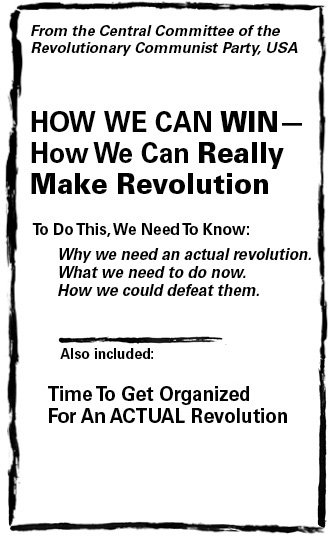Reflections on Ferguson, Five Years Later
| revcom.us
by some comrades who had responsibility for directly leading the struggle in Ferguson
This past weekend marked the fifth anniversary of the Ferguson rebellion. Michael Brown, a Black youth who had recently graduated high school, was shot down with his hands in the air by a pig in Ferguson, Missouri, a suburb of St. Louis. And that was not enough: The pigs then let Michael Brown’s dead body lie in the street for hour after hour after hour. The anger spread through the Black neighborhood where Michael’s lifeless body lay, like a lynching victim in the “old South”; that night people rose up and righteously defended themselves against heavily armed police. Night after night these youth fought back—despite the “best efforts” of “firemen” like Al Sharpton and too many others to stuff them back into the lives that this system has hammered them into.
Radical and revolutionary youth from around the country, including members of the Revolution Club, came to Ferguson to lend support to this uprising and many held demonstrations in their own cities. Black young people poured into the streets all over the country. Youth of other nationalities, including a lot of white youth, joined into this and also began disrupting symphonies and baseball games to demand of others, “which side are you on?” Something new was coming on the scene.
When the DA in the case delivered the “no indictment” decision in late November of that year and the craven murderer-in-blue of Michael Brown walked free, even more people poured into the streets—this time by the thousands and tens of thousands around the country. For a month they went to the streets day after day and night after night, blocking highways and disrupting business as usual. The police responded with heavy, often militarized repression, but were often forced to back off.
Important questions about the depth and scope of the oppression of Black people were beginning to be raised in the minds of millions... about why this was still going on and what to do about it... and where all this comes from. People were beginning to get a sense of their own potential power when they joined together.
At the same time, the ruling capitalist-imperialist class, Democratic Party division, was moving to “corral and domesticate” the protest, in the phrase of Bob Avakian. The Obama administration flew selected activists to the White House for a meeting. Certain voices—those promoting reforms and programs to work with and develop “understanding” and conciliation between the police and the people—were given a platform and promoted in the media; and certain voices—those of resistance and rebellion, those of revolution—were “whited out.” The framework of identity politics and restorative justice, which puts forward changing people’s understanding within the current system as the road forward, was given support from forces high up in the ruling class. Complex multi-point programs of reform were put out. Parades of Black politicians began to be elected to district attorney, city council, and mayor, and many, many new Black cops were hired—the Ferguson PD has gone from four Black pigs to 22 since the rebellion. Black police chiefs were installed. The Obama Department of Justice (DOJ) began promoting “consent decrees” promising to bring in a new era of “accountability.”1 Body cameras were put on police.
Meanwhile, heavy charges and sentences began coming down on those who had been arrested in the demonstrations. At least six activists in the struggle have lost their lives, some in what were, at the least, suspicious circumstances. The struggle did continue—masses of people, especially Black youth, rose up in Baltimore after the police murdered Freddie Gray in 2015, and 3,000 demonstrated in New York in October 2015 in a demonstration called by Rise Up October, a coalition which the Revolutionary Communist Party (RCP) helped initiate. But especially going into and then coming out of the election of Trump, the struggle subsided.
Five Years Later: And What Has Changed
Now, five years later, what has changed? In the wake of the rebellions initially sparked by the death of Michael Brown, the fascist and openly white supremacist Trump came into office, in part as a response to those rebellions. The rate of police murder has not changed since 2014, body cams and all. It is still an epidemic, taking roughly 1,000 lives a year. The rate of cops who get charged after killing someone has remained the same, which is virtually nil. The cops who do go to trial continue to get acquitted, at the same rate as before.
The MOST IMPORTANT Lessons of Ferguson
But the lesson here is NOT that rebellion and mass struggle does no good. Quite the opposite. Mass struggle, especially when it gets to the point that Ferguson did, can play an extremely critical role in advancing things toward revolution. The masses of people raise their heads—to quote HOW WE CAN WIN—How We Can Really Make Revolution, society is “jolted” and “many people question and resist what they normally accept.” We wrote above about some of what begins to come out in these struggles and some of what begins to come into being, but this deserves repeated emphasis.
BUT what the last five years so painfully make clear is first, that as Bob Avakian put forward in Why We Need An Actual Revolution And How We Can Really Make Revolution: “White supremacy and capitalism—they have been completely interwoven and tightly ‘stitched together’ through the whole development of this country, down to today; to attempt to really put an end to white supremacy while maintaining the system of capitalism would tear the entire fabric of the country apart. White supremacy and capitalism—it is not possible to overcome and finally abolish the one without overthrowing and finally abolishing the other.” No reform under this system will ever be anything more than partial and temporary and this has been borne out by what has followed from Ferguson.
It really IS true, as BA says, that there are two choices—“either, live with all this—and condemn future generations to the same, or worse, if they have a future at all—or, make revolution!”
From this standpoint, these struggles cannot be left as they are, or simply supported—even militantly supported—but must be transformed, through struggle, into revolutionary understanding, determination and organization. (from a Revolution Club, Los Angeles statement on police murder of Stephon Clark--emphasis added)
So, given this, what DOES need to be done? To again cite BA’s speech, Why We Need An Actual Revolution And How We Can Really Make Revolution:
So, with this understanding and orientation, how do we go about hastening while awaiting? The means for doing this is concentrated in the formulation: “Fight the Power, and Transform the People, for Revolution.” Let’s start with the aim of all this—Revolution. In BAsics 3:1, I put it like this: “Let’s get down to basics: We need a revolution. Anything else, in the final analysis, is bullshit.” That is another simple and basic truth. We need to go to people—not just one or two people, not just a small number of people, but masses of people, reaching all over the country, in every part of society—straight up with revolution—instead of just letting “where they are at” set the terms, and trying to somehow “bring in” some idea about revolution within that limited framework. As BAsics 3:1 goes on to say: We do need to unite with people in all sorts of struggles short of revolution; but it is frankly ridiculous to think that something short of revolution could solve all the monumental problems and monstrous outrages that people face under this system. On the basis of going to people straight up with revolution, then, coming from that place, we need to unite with people in fighting injustice and oppression, and struggle to win more and more people to see the need and the possibility for revolution, and to get with this.
Here we have to say that while the political line of reformism coming from other forces (and given backing by Obama) held back and neutered the struggle in Ferguson, there were questions of revolutionary orientation and strategy within the RCP itself that did harm to what is most needed: the cause of revolution. To too large an extent, we ourselves did not proceed from what is cited above and thus fundamentally did NOT play the vanguard role required at that time. While the Revolution Clubs and people influenced by the party mobilized the masses in militant struggle and courageously took on the forces of repression, and while we fought against conciliationism and reform, we did this too much from within the terms of what would advance the immediate struggle against police murder.
We did not enough ground ourselves and everyone else in the revolution we need in doing so and come at everything from the standpoint laid out above in BA’s speech and BAsics 3:30. We did not anywhere near enough build on and build off of the truly great strength that the revolution has in Bob Avakian—in what he’s brought forward in the science through which to understand the world, the strategy for the revolution we need, and the vision of the new society as crystallized in the Constitution for the New Socialist Republic in North America, which he authored.
This significant and costly shortcoming flowed from the idea that communists should above all, or as a starting point at least, put the immediate unity in the struggle and proving oneself the “best fighter” and only then put forth your revolutionary understanding once you have “established yourself.” This has been a historically dominant line in the communist movement, and it is one that is reinforced by the dominant social relations and ideas of this system. But if you don’t struggle with the ways in which this system conditions HOW people see the causes, goals, and means of what is needed right from the beginning and all the way through, then you will never get to communism and you won’t even make revolution. For these reasons this line has been and is one of the chief targets of the Cultural Revolution in the RCP, led by BA. (The Cultural Revolution within the RCP,USA was launched by Bob Avakian in the early 2000s, at a point when the whole party was in danger of giving up on the goal of revolution, in any real sense, and becoming revisionist. This is discussed in great depth in Part 4 of The New Communism. The current National Tour to Get Organized for an ACTUAL Revolution is a concentrated expression of that Cultural Revolution. This Tour aims to build the mass revolutionary movement we need, including the thousands needed right now to form an organized core force FOR revolution and, as a crucial objective and necessary part of that, fundamentally and decisively break with that revisionist line.
What Must Be Done Now
Today, five years later, we write as a fascist and openly white supremacist regime rules from the White House and moves to further clamp fascism fully into place. Right now, this government is imprisoning and torturing immigrants, including children who are being torn from their parents, for the “crime” of fleeing repression and starvation. Right now, Trump uses the words of Hitler to describe Black people and the neighborhoods they live in. Right now, there are moves to strip women and LGBTQ people of basic rights, and there are threats of genocidal nuclear war coming from Trump (and actual barbaric wars now being waged with U.S. support and/or direct participation in Yemen, Afghanistan, Syria, Somalia, and other places). The breakneck plunder of the environment poses whether humanity will even continue to exist into the next century. And right now, the police continue murdering and brutalizing Black people, Latinos, immigrants, Native Americans, and other oppressed people—and now have open backing from the White House and DOJ. To paraphrase Gil Scott-Heron, in talking about an earlier struggle against police murder, “the dogs are still in the street.”
In fact, right now we need more, not less, resistance. But most of all we need a movement for revolution in the thousands that enters into and builds this resistance in the way called for above. This past weekend people went into the streets in a number of cities to demonstrate. Especially if this signals the basis for a new upsurge, revolutionary communists should welcome and be part of struggle on this front, along the lines laid out above, drawing out and struggling over the correct lessons of the past five years, and building up forces for the only solution to the problem: revolution.
How to do that is laid out in HOW WE CAN WIN—How We Can Really Make Revolution:
Those who catch the worst hell under this system, and those who are sickened by the endless outrages perpetrated by this system, need to join up with this revolution. Thousands need to get organized into the ranks of the revolution now, while millions are being influenced in favor of this revolution. We have seen the potential for this in the protests that have taken place against police brutality and murder, and other ways in which large numbers of people have gone up against the established authorities and the political “rules of the game.” But this needs to be transformed, through struggle, into revolutionary understanding, determination, and organization. The organized forces and the leadership of this revolution must become the “authority” that growing numbers of people look to and follow—not the lying politicians and media of this oppressive system—not those who front for the oppressors and preach about “reconciliation” with this system—not those who turn people against each other when they need to be uniting for this revolution. While many people will do positive things in opposing the crimes of this system, we need to approach everything—evaluate every political program and every organized force in society, every kind of culture, values and ways of treating people—according to how it relates to the revolution we need, to end all oppression. We should unite with people whenever we can, and struggle with them whenever we need to, to advance the revolution.
1. A few months after the initial upheaval, Obama’s Department of Justice reversed the verdict on what actually happened—saying that Michael Brown did not have his hands up. The movie Stranger Fruit actually walks through the testimony and lays out an extremely strong case that Brown’s hands were up—with a number of witnesses, including some white, who maintained that; enough that the case should have gone to trial. But this was important for Obama to do in order to undercut the whole basis that the struggle was righteous and that the legal system is set up to justify such murders; and in particular, they were trying to gut the legitimacy of what became the cry of those fall protests: “hands up, don’t shoot!” [back]
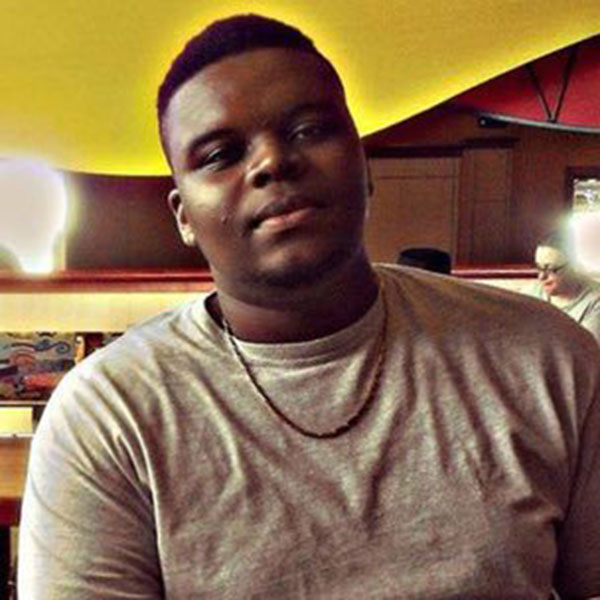
Michael Brown
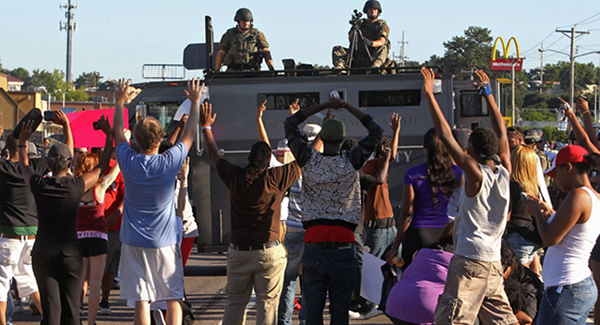
Ferguson, Missouri, August 13, 2014. Photo: AP
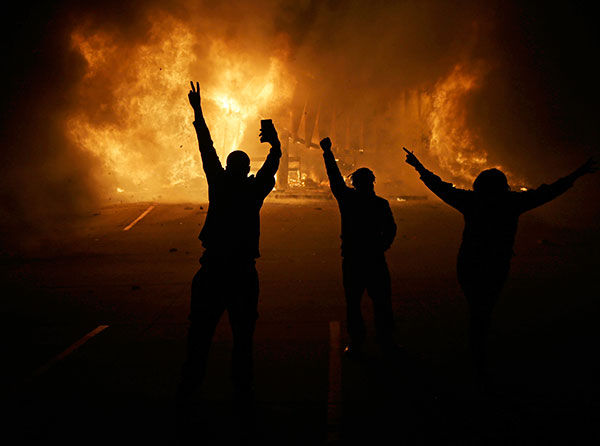
Ferguson, Missouri, November 25, 2014. Photo: AP
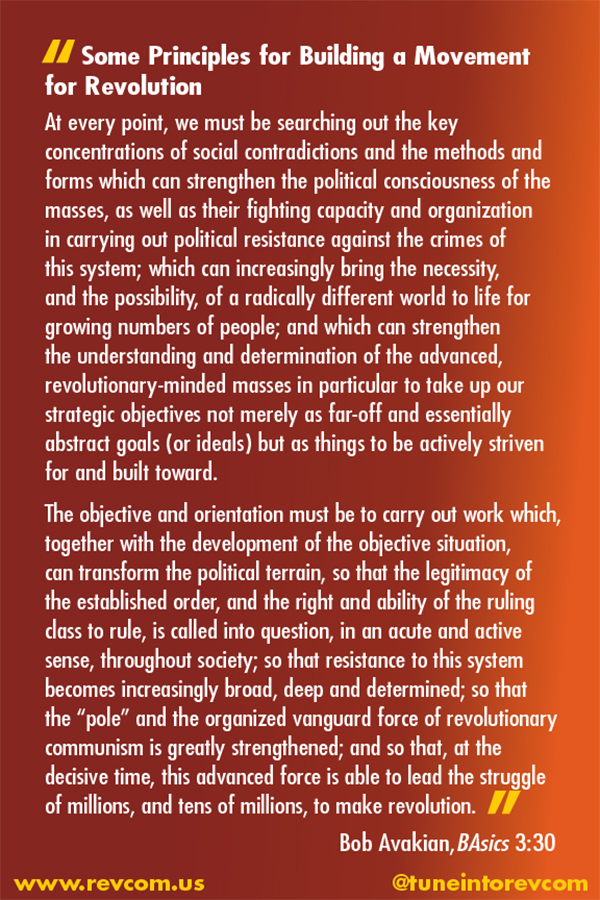
The Oppression of Black People and Other People of Color, by Bob Avakian
An excerpt from Why We Need An Actual Revolution And How We Can Really Make Revolution
Get a free email subscription to revcom.us:


